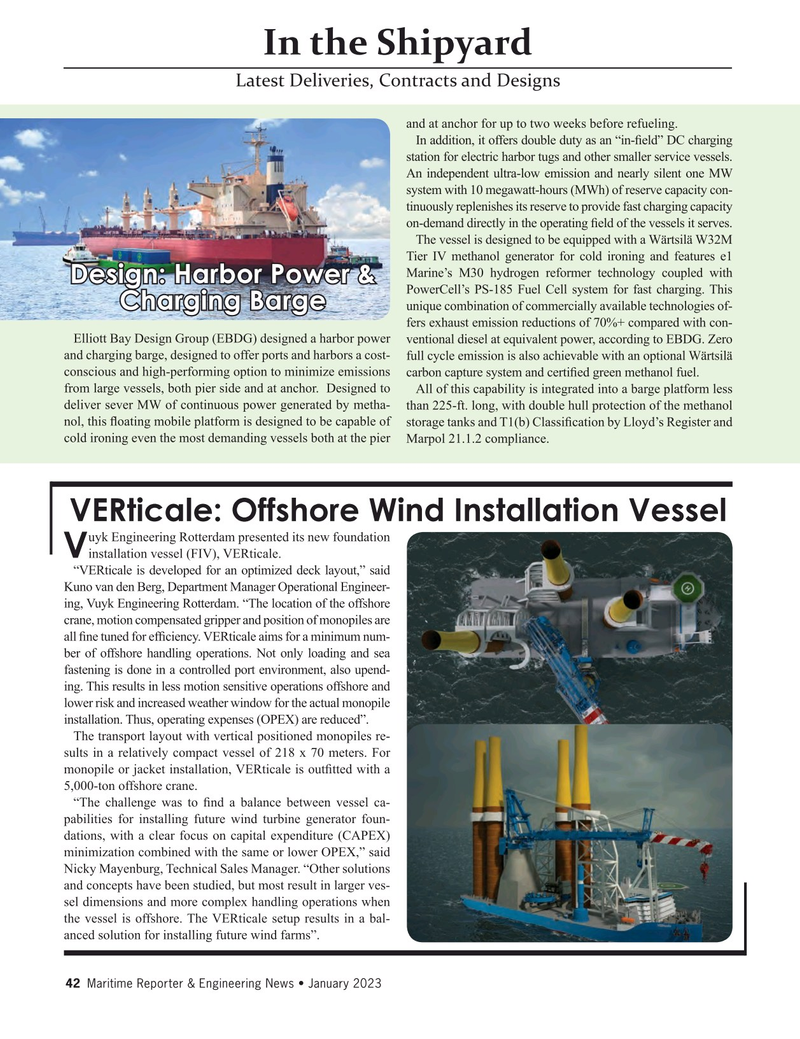
Page 42: of Maritime Reporter Magazine (January 2023)
The Ship Repair & Conversion Edition
Read this page in Pdf, Flash or Html5 edition of January 2023 Maritime Reporter Magazine
In the Shipyard
Latest Deliveries, Contracts and Designs and at anchor for up to two weeks before refueling.
In addition, it offers double duty as an “in-? eld” DC charging station for electric harbor tugs and other smaller service vessels.
An independent ultra-low emission and nearly silent one MW system with 10 megawatt-hours (MWh) of reserve capacity con- tinuously replenishes its reserve to provide fast charging capacity on-demand directly in the operating ? eld of the vessels it serves.
The vessel is designed to be equipped with a Wärtsilä W32M
Tier IV methanol generator for cold ironing and features e1
Marine’s M30 hydrogen reformer technology coupled with
Design: Harbor Power &
PowerCell’s PS-185 Fuel Cell system for fast charging. This
Charging Barge unique combination of commercially available technologies of- fers exhaust emission reductions of 70%+ compared with con-
Elliott Bay Design Group (EBDG) designed a harbor power ventional diesel at equivalent power, according to EBDG. Zero and charging barge, designed to offer ports and harbors a cost- full cycle emission is also achievable with an optional Wärtsilä conscious and high-performing option to minimize emissions carbon capture system and certi? ed green methanol fuel.
from large vessels, both pier side and at anchor. Designed to All of this capability is integrated into a barge platform less deliver sever MW of continuous power generated by metha- than 225-ft. long, with double hull protection of the methanol nol, this ? oating mobile platform is designed to be capable of storage tanks and T1(b) Classi? cation by Lloyd’s Register and cold ironing even the most demanding vessels both at the pier Marpol 21.1.2 compliance.
VERticale: Offshore Wind Installation Vessel uyk Engineering Rotterdam presented its new foundation
Vinstallation vessel (FIV), VERticale.
“VERticale is developed for an optimized deck layout,” said
Kuno van den Berg, Department Manager Operational Engineer- ing, Vuyk Engineering Rotterdam. “The location of the offshore crane, motion compensated gripper and position of monopiles are all ? ne tuned for ef? ciency. VERticale aims for a minimum num- ber of offshore handling operations. Not only loading and sea fastening is done in a controlled port environment, also upend- ing. This results in less motion sensitive operations offshore and lower risk and increased weather window for the actual monopile installation. Thus, operating expenses (OPEX) are reduced”.
The transport layout with vertical positioned monopiles re- sults in a relatively compact vessel of 218 x 70 meters. For monopile or jacket installation, VERticale is out? tted with a 5,000-ton offshore crane.
“The challenge was to ? nd a balance between vessel ca- pabilities for installing future wind turbine generator foun- dations, with a clear focus on capital expenditure (CAPEX) minimization combined with the same or lower OPEX,” said
Nicky Mayenburg, Technical Sales Manager. “Other solutions and concepts have been studied, but most result in larger ves- sel dimensions and more complex handling operations when the vessel is offshore. The VERticale setup results in a bal- anced solution for installing future wind farms”. 42 Maritime Reporter & Engineering News • January 2023
MR #1 (34-43).indd 42 1/5/2023 4:10:48 PM

 41
41

 43
43
